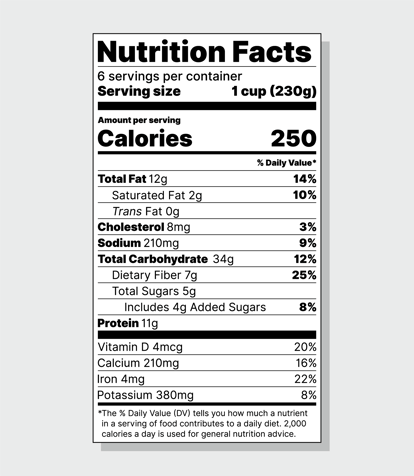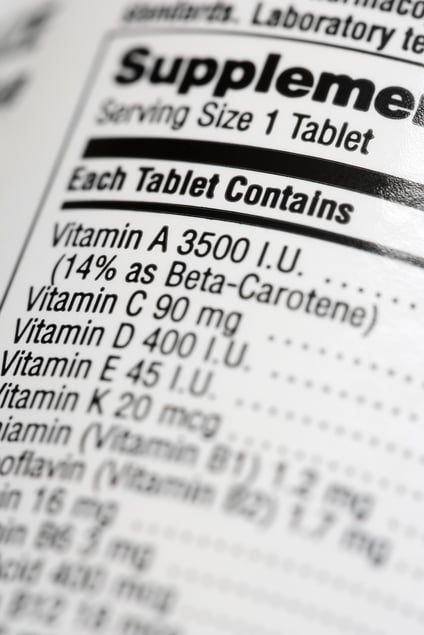Reviewed and Approved by Maged Sharaf, Ph.D., Senior Director, Labeling, Cannabis and Claims Consulting Services, EAS Consulting Group, a Certified Group company
1-Minute Summary- Supplement facts panels are exclusive to dietary supplements, detailing ingredients; Nutrition facts panels are for food, outlining nutritional content.
- Important requirements for supplement facts panels include listing serving size and dietary ingredients, both with and without a Reference Daily Intake (RDI) or a Daily Reference Value (DRV).
- Non-compliance with the FDA's regulations may lead to recalls, legal actions, and substantial fines, emphasizing the importance of understanding and adhering to these guidelines.
- Design elements for supplement facts panels are governed by 21 CFR 101.36, including font size, and text justification.
- It's important to be updated with both federal and local regulatory standards, including those by the Federal Trade Commission on advertisements, and potential state-level regulations.
For manufacturers of dietary supplements, a key area that always garners attention is the distinction between supplement facts vs nutrition facts. For quality assurance teams, it is essential to grasp these differences to ensure your product labels are compliant with FDA regulations.
This blog post focuses on the requirements of your supplement facts panel, but also touches on some requirements of nutrition facts panels to help draw distinctions and clear any confusion.
Supplement Facts vs Nutrition Facts: A Brief Overview
At first glance, both nutrition facts and supplement facts panels might seem similar, but their primary functions and what they represent are distinct.
Nutrition Facts: Found on food products, they detail the nutritional content of the item.
Supplement Facts: Exclusive to dietary supplements; highlight their ingredients, quantities, and other specifics.

Nutrition facts panels are used on food products and include information about the product’s nutritional content.

Supplement facts panels are used on dietary supplements and highlight the product’s ingredients.
What Information Is Required on the Supplement Facts Panel?
When navigating the specifics of a supplements facts panel, there are certain mandatory elements that you must include to ensure you’re meeting regulatory requirements. Let’s walk through each requirement and cite the relevant regulation:
Serving Size
This represents the quantity of the supplement that is recommended for consumption in a single instance. For example, on a vitamin C supplement label, the serving size might be listed as "1 Capsule". 21 CFR 101.36(b)(1)
Servings Per Container
This information isn’t required when it is the same information as in the net quantity of contents statement. For example, if the net quantity of contents statement is “50 Capsules” and the Serving Size is “1 Capsule”, the Servings Per Container is 50 Capsules and does not need to be listed. 21 CFR 101.36(b)(1)(ii)
Information on Dietary Ingredients that have a Reference Daily Intake (RDI) or a Daily Reference Value (DRV) as Established in § 101.9(c) and their Subcomponents
This includes:
- Total calories
- Total fat
- Saturated fat
- Trans fat
- Cholesterol
- Sodium
- Total carbohydrate
- Dietary fiber
- Total sugars
- Added sugars
- Protein
- Vitamin D
- Calcium
- Iron
- Potassium
These ingredients must be declared when they are present in a dietary supplement in quantitative amounts by weight that exceed the amount that can be declared as zero in nutrition labeling of foods. 21 CFR 101.36(b)(2)(i)
The percent of the Daily Value of all dietary ingredients declared under 21 CFR 101.36(b)(2)(i) must be listed; no percent of the Daily Value shall be given for subcomponents for which DRVs or RDIs have not been established (e.g., total sugars). 21 CFR 101.36(b)(2)(iii)
Information on Dietary Ingredients for Which RDI's and DRV's Have not Been Established
You must declare dietary ingredients for which FDA has not established RDIs or DRVs and that are not subject to regulation under 21 CFR 101.36(b)(2). These are referred to as “other dietary ingredients” and shall be declared by their common or usual name when they are present in your product. 21 CFR 101.36(b)(3)(i)
- The quantitative amount by weight per serving of other dietary ingredients must be declared. 21 CFR 101.36(b)(3)(ii)
- Any proprietary blend of ingredients must be included in the list of dietary ingredients. 21 CFR 101.36(c)
You should end up with a supplement facts panel that looks close to this example provided by FDA:

21 CFR 101.36 includes thousands of words of information that can quickly confuse even seasoned labeling experts, so read the regulations closely and reach out to an expert for help if needed, such as those at EAS Consulting Group.
Supplement Facts vs Nutrition Facts: The Distinctions
There are several differences between supplement facts panels and nutrition facts panels. A good starting point when parsing these differences is this list on FDA’s website of 5 major differences between supplement facts panels and nutrition facts panels:
- You must list dietary ingredients without RDIs or DRVs in the supplement facts panel for dietary supplements. You are not permitted to list these ingredients in the nutrition facts panel for foods.
- You may list the source of a dietary ingredient in the supplement facts panel for dietary supplements. You cannot list the source of a dietary ingredient in the nutrition facts panel for foods.
- You are not required to list the source of a dietary ingredient in the ingredient statement for dietary supplements if it is listed in the supplement facts panel.
- You must include the part of the plant from which a dietary ingredient is derived in the supplement facts panel for dietary supplements. You are not permitted to list the part of a plant in the nutrition facts panel for foods.
- You are not permitted to list "zero" amounts of nutrients in the supplement facts panel for dietary supplements. You are required to list "zero" amounts of nutrients in the nutrition facts panel for food.
What About Label Design Regulations?
Everything in this industry, it seems, is heavily regulated, and that includes the design elements on the labels in general and on the supplement facts panel specifically.
Nutrition labeling of food is covered under 21 CFR 101.9. For supplements labeling, 21 CFR 101.36 contains regulations for label design elements, such as font size, text justification, and more. Here are a few examples:
- The title, “Supplement Facts,” shall be set in a type size larger than all other print size in the nutrition label and, unless impractical, shall be set full width of the nutrition label. The title and all headings shall be bolded to distinguish them from other information. 21 CFR 101.36(e)(1)
- The nutrition information shall be enclosed in a box by using hairlines. 21 CFR 101.36(e)(3)
- All information within the nutrition label shall utilize a single easy-to-read type style. 21 CFR 101.36(e)(3)(i)
There are several more label design requirements throughout 21 CFR 101.36, so read closely. This Labeling Type Size Guide from our regulatory arm, EAS Consulting Group, can help you design compliant labels.
What About Advertising?
It's also worth noting that advertisements of both foods and dietary supplements are under the jurisdiction of the Federal Trade Commission and, while the FDA sets the baseline, there may be additional state-level regulations that companies must adhere to.
Always ensure you are updated with both federal and local regulatory standards.
The Importance of Dietary Supplements Labeling
As you can see, dietary supplements labeling, as per the guidelines set forth by the U.S. Food and Drug Administration (FDA), is governed by rigorous regulations to ensure consumers are well-informed about what they are consuming.
Understanding FDA regulations helps in:
- Meeting Product Compliance: Adhering to the FDA's standards ensures that dietary supplements on the market meet stringent safety and labeling requirements.
- Avoiding Legal Ramifications: Non-compliance with FDA regulations can lead to recalls, legal actions, and hefty penalties. A deep understanding and adherence to these guidelines prevent potential legal complications.
- Ensuring Product Integrity and Consumer Trust: Transparent and accurate labeling, in line with FDA regulations, enhances consumer confidence in the product's safety and efficacy. It assures them that the products they are consuming meet high-quality standards set by a trusted regulatory body.
If you need help, Certified Group Companies have you covered.
EAS Consulting Group can review your dietary supplement labels for compliance.
Certified Laboratories can perform your dietary supplement testing.
Reach out and we’ll be glad to help.
